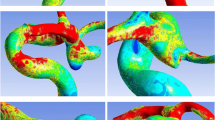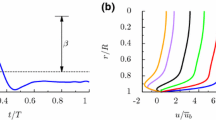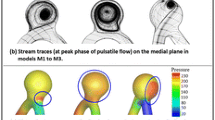Abstract
It has recently been shown that the aspect ratio (dome/neck) of an aneurysm correlates well with intraaneurysmal blood flow. Aneurysms with an aspect ratio larger than 1.6 carry a higher risk of rupture. We examined the effect of aspect ratio (AR) on intra-aneurysmal flow using experimental models. Flow visualization with particle imaging velocimetry and measurement of wall shear stress using laser Doppler anemometry were performed on three different aneurysm models: AR 0.5, 1.0, and 2.0. Intraaneurysmal flow consists of inflow, circulation, and outflow. Rapid inflow impinged on the distal neck creating a stagnant point. Rapid flow and maximum wall shear stress were observed in the vicinity of the stagnant point. By changing the Reynold’s number, the stagnant point moved. By increasing the AR of the aneurysm, vortices inside the aneurysm sac closed and very slow flow was observed, resulting in very low shear stress markedly at a Reynold’s number of 250, compatible with the diastolic phase. In the aneurysm model AR 2.0, both rapid flow at the neck and vortices inside the aneurysm are sufficient to activate platelets, making a thrombus that may anchor on the dome where very slow flow takes place. Hemodynamics in aneurysms larger than AR 2.0 definitely contribute to thrombus formation.
Similar content being viewed by others
References
van Gijin J, Rinkel GJ (2001) Subarachnoid hemorrhage: diagnosis, causes and management. Brain 124:249–278
Weir B (2002) Unruptured intracranial aneurysms: a review. J Neurosurg 96:3–42
Forbus WD (1930) On the origin of milliary aneurysms of the superficial cerebral arteries. Bull Johns Hopkins Hosp 47:239–284
Crawford T (1959) Some observation of the pathogenesis and natural history of intracranial aneurysms. J Neurol Neurosurg Psychiatry 22:259–266
Stehbens WE (1963) Aneurysms and anatomical variation of cerebral arteries. Arch Pathol 75:45–64
Carmichael R (1950) The pathogenesis of non-inflammatory cerebral aneurysms. J Pathol Bacteriol 62:1–19
Hashimoto N, Handa H, Hazama F (1978) Experimentally induced cerebral aneurysms in rats: part I. Surg Neurol 10:3–8
Hashimoto N, Handa H, Hazama F (1979) Experimentally induced cerebral aneurysms in rats: part II. Surg Neurol 11:243–246
Hashimoto N, Handa H, Nagata I, Hazama F (1980) Experimentally induced cerebral aneurysms in rats: part V. Relation of hemodynamics in the circle of Willis to formation of aneurysms. Surg Neurol 13:41–45
Chyatte D, Lewis I (1997) Gelatinase activity and the occurrence of cerebral aneurysms. Stroke 28:799–804
Chyatte D, Bruno G, Desai S, Todor R (1999) Inflammation and intracranial anerusms. Neurosurgery 45:1137–1147
Bruno G, Todor R, Lewis I, Chyatte D (1998) Vascular extracellular matrix remodeling in cerebral aneurysms. J Neurosurg 89:431–440
Kataoka K, Taneda M, Asai T, Kinoshita A, Ito M Kuroda R (1999) Structural fragility and inflammatory response of ruptured cerebral aneurysms. A comparative study between ruptured and unruptured cerebral aneurysms. Stroke 30:1396–1401
Frosen J, Piippo A, Paetau A, Kangasniemi M, Nemela M, Hernesniemi J, Jaaskelainen J (2004) Remodeling of saccular cerebral artery aneurysm wall is associated with rupture. Histological analysis of 24 unruptured and 42 ruptured cases. Stroke 35: 2287–2293
Roach MR, Scott S, Ferguson GG (1972) The hemodynamic importance of the geometry of bifurcations in the circle of Willis (glass model studies). Stroke 3:255–267
Steiger HJ, Reulen HJ (1987) Basic flow structure in saccular aneurysm: a flow visualization study. Heart Vessels 3:55–65
Steiger HJ, Liepsch DW, Poll A, Reulen HJ (1988) Hemodynamic stress in terminal saccular aneurysms: a laser-Doppler study. Heart Vessels 4:162–169
Glynn LE (1940) Medial defects in the circle of Willis and their relation to aneurysm formation. J Pathol Bacteriol 51:213–222
Cajander S, Hassler O (1976) Enzymatic destruction of the elastic lamella at the mouth of cerebral berry aneurysm. Acta Neurol Scand 53:171–181
Kim SC, Singh M, Huang J, Prestigiacomo CJ, Winfree CJ, Solomon RA, Connolly Jr ES (1997) Matrix metalloproteinase-9 in cerebral aneurysms. Neurosurgery 41:642–647
Futami K, Yamashita J, Tachibana O, Higashi S, Ikeda K, Yamashima T (1995) Immunohistochemical alterations of fibronectin during the formation and proliferative repair of experimental cerebral aneurysms in rats. Stroke 26:1654–1659
Sasaki K, Ujiie H, Higa T, Hori T, Shinya N, Uchida T (2004) Rabbit aneurysm model mediated by the application of elastase. Neurol Med Chir (Tokyo) 44:467–474
Kamiya A, Togawa T (1980) Adaptative regulation of wall shear stress to flow change in the canine carotid artery. Am J Physiol 239: H14–H21
Moncada S, Palmer RMJ, Higgs EA (1991) Nitric oxide: physiology, pathology and pharmacology. Pharmacol Rev 43:109–142
Masuda H, Zhuang YJ, Singh TM, Kawamura K, Murakami M, Zarins CK, Gragov S (1999) Adaptive remodelling of internal elastic lamina and endothelial lining during flow-induced arterial enlargement. Arterioscler Thromb Vasc Biol 19:2298–2307
Kroll MH, Hellums JD, McIntire LV, Schafer AI, Moake JL (1996) Platelets and shear stress. Blood 88:1525–1541
Zhang J, Bergeron AL, Yu Q, Sun C, McBride L, Bray PF, Dong J (2003) Duration of exposure to high fluid shear stress is critical in shear-induced platelet activation-aggregation. Thromb Haemost 90:672–678
Ruggeri ZM (1997) Mechanisms initiating platelet thrombus formation. Thromb Haemost 78:611–616
Ujiie H, Tachibana H, Hiramatsu O, Hazel AL, Matsumoto T, Ogasawara Y, Nakajima H, Hori T, Takakura K, Kajiya F (1999) Effects of size and shape (aspect ratio) on the hemodynamics of saccular aneurysms: a possible index for surgical treatment of intracranial aneurysms. Neurosurgery 45:119–130
Ujiie H, Tamano Y, Sasaki K, Hori T (2001) Is the aspect ratio a reliable index for predicting the rupture of a saccular aneurysm? Neurosurgery 48:495–503
Weir B, Amidei C, Kongable G, Findlay JM, Kassel NF, Kelly J, Dai L, Karrison TG (2003) The aspect ratio (dome/neck) of ruptured and unruptured aneurysms. J Neurosurg 99:447–451
Yamaguchi R, Torisu A, Haida S, Nakazawa N, Ujiie H, Tanishita K (2005) Wall shear stress accompanied with initial, progressive, and developed aneurysm induced around anterior communicating artery. Trans Jpn Soc Mech Eng 71B:1573–1578
Ujiie H, Liepsch DW, Goetz M, Yamaguchi R, Yonetani H, Takakura K (1996) Hemodynamic study of the anterior communicating artery. Stroke 27:2086–2094
Kayembe KNT, Sasahara M, Hazawa F (1984) Cerebral aneurysms and variations in the circle of Willis. Stroke 15:846–850
Ujiie H, Satoh K, Onda H, Oikawa A, Kagawa M, Takakura K, Kobayashi N (1993) Clinical analysis of incidentally discovered unruptured aneurysms. Stroke 24:1850–1856
Stehbens WE (1975) Flow in glass models of arterial bifurcations and berry aneurysms at low Reynolds numbers. Q J Exp Phisiol 60:181–192
Roach MR (1978) A model study of why some intracranial aneurysms thrombose but others rupture. Stroke 9:583–587
Ujiie H, Edwards DH, Griffith TM (2002) Endogenous nitric oxide synthesis differentially modulates pressure-flow and pressureconductance relationships in the internal and external carotid artery circulations of the rat. Neurol Med Chir (Tokyo) 42: 527–535
Zhuang YJ, Singh TM, Zarins CK, Masuda H (1998) Sequential increases and decreases in blood flow stimulates progressive intimal thickening. Eur J Endovasc Surg 16:301–310
Bell DN, Spain S, Goldsmith HL (1990) The effect of red blood cells on the ADP-induced aggregation of human platelets in flow through tubes. Thromb Haemost 63:112–121
Goldsmith HL, Bell DN, Bravoc S, Steinberg A, Mclntosh F (1995) Physical and chemical effects of red cells in the shear-induced aggregation of human platelets. Biophys J 69:1584–1595
Joist JH, Bauman JE, Sutera SP (1998) Platelet adhesion and aggregation in pulsatile shear flow: effects of red blood cells. Thromb Res 92:S47–S52
Medved L, Nieuwenhuizen W (2003) Molecular mechanism of initiation of fibrinolysis by fibrin. Thromb Haemost 89:409–419
Author information
Authors and Affiliations
Corresponding author
Rights and permissions
About this article
Cite this article
Yamaguchi, R., Ujiie, H., Haida, S. et al. Velocity profile and wall shear stress of saccular aneurysms at the anterior communicating artery. Heart Vessels 23, 60–66 (2008). https://doi.org/10.1007/s00380-007-0996-7
Received:
Accepted:
Published:
Issue Date:
DOI: https://doi.org/10.1007/s00380-007-0996-7




